| dc.description.abstract | The flow at RGS 3KD06 on 13/03/2013 was estimated at approximately 0.006 m3/s (520 m3/d), which is 53% of the lowest recorded daily flow for March (0.011.28 m3/s, 974 m3/d). The concerns regarding the low flows on the Mkurumudzi River led to the need to quantify the available water resource, assessment and formulation of a water allocation framework for the catchment. An abstraction survey was conducted along the entire length of the Mkurumudzi River. Abstraction points were identified, mapped and abstraction volumes assessed. The assessment of the water resource was conducted using MIKE basin software and Danish Hydrologic Institute‘s (DHI) Nedbør-Afrstrømnings-Model (NAM). The rainfall runoff model was done using NAM and calibrated for a period of 30 years; the input time series comprised of observed flow data for RGS 3KD06, evapotranspiration data and precipitation data. The calculated Root Mean Square Error-observations standard deviation ratio (RSR) was 0.364 while Nash-Sutcliffe Efficiency (NSE) was 0.868. The NSE approached unity indicating that the predicted and the observed discharge values had a good correlation hence the model could fairly simulate the catchment response. The output time series was used in MIKE basin model. The MIKE basin model was designed in ArcGIS 10.0, the water users and reservoirs were digitized and their time series of abstraction rates uploaded onto them. The model was run without the abstraction time series for the abstractors in the catchment to establish the environmental water requirements at the mouth of the river, the model was then run again with all existing current abstractions to establish a time series for the mouth of the river, and this time series was then used to compute the monthly reserve flow values which were compared to the environmental water requirements for the mouth of the river to assess the water balance and allocations. From the flow duration curve, the reserve flow at the estuary was calculated at 0.130 m3/s (Q95), the normal flow at 0.190 m3/s (Q80) and the flood flow at 0.520 m3/s (Q50). This catchment had 18 abstraction points with a total abstraction of 506 m3/day, at this time the mining and irrigation scheme had not started operations; The total authorised normal flow abstractions with valid documentation were 0.023 m3/s; the total authorised flood flow abstractions with valid documentation was 1.20 m3/s. The water balance and allocation analysis in MIKE basin showed a deficit of water for the environmental flow requirements in the months of July and August, 0.023 m3/s and 0.010 m3/s respectively. The water allocation framework sets out that any future demands to be allocated water should be based on normal flows of 0.02 m3/s and flood flows of 0.13 m3/s. This analysis did not take into account climate change variability. This thesis sets out the need to further conduct a comprehensive and holistic watershed modelling (hydrogeological) of Mukurumudzi basin and the reservoirs that takes into account the groundwater dynamics and water quality since these will have a general impact onto health, sanitation and living standards of the people that rely on the catchment‘s groundwater resource for domestic use. | en_US |

